A birdhouse is often called a nesting house because it offers a safe place for birds to build their nests, protecting them from weather conditions and predators. During the winter season, they give birds a place to huddle together for warmth away from the cold air.
Outdoor birdhouses serve as the common answer to the problems that arise in your garden, such as controlling pests and weeds, keeping flowers pollinated, and conserving plants.
Various species of birds provide great help for your yard as some eat insects and weed seeds, while others love to sip nectar from flowers to help pollinate.
We Recommend
First, which birds you want to attract into birdhouse?
Wrens – House wrens and Carolina wrens are among the easiest birds to attract to birdhouses. House wrens prefer their houses hanging from a small tree in the middle of a yard, or along the border of an open yard. Carolina wrens will go into a birdhouse that is well hidden in natural habitat.
Bluebirds – All three bluebird species (eastern, western, and mountain) will use a birdhouse. Bluebirds feed their young insects they capture in open, grassy fields. Their houses are most acceptable if placed on a post that faces or is very near, an open field where they can find food.
Chickadees and Titmice – All species of chickadees and titmice will use birdhouses. These birds nest in dense natural habitat, such as thickets or stands of small trees.
Tree swallows – A tree swallow house should be near water. Like bluebirds, tree swallows like to catch their insect food above open fields or water. Their houses should be placed facing this kind of natural habitat.
Purple Martins – Purple martins use apartment houses that accommodate numerous families. They also like bird-houses made out of gourds. A long sweep of grassy lawn or field should surround the martin apartment house as these birds hunt insects on the wing. A nearby utility wire may make the habitat even more attractive because purple martins like to perch on or near their houses.
Wood Ducks – One of the few cavity-nesting ducks, wood ducks naturally nest in a tree cavity, but readily inhabit a house. These tree ducks look for houses that are in trees on or near lakes, rivers, or streams, to which they can lead their broods after the ducklings vacate the house.
Screech-owls – Roosting owls will sit in entrance holes at dusk. Birdhouses mounted on the trunk of a tree in a woodland of mature trees will bring owl occupancy either for nesting in early spring or for roosting in winter.
American Robins – Because they often nest on ledges and downspouts on people’s houses, robins also may use a shelter that is a three-sided birdhouse. The shelter should be mounted in a location surrounded by natural habitat, including mature trees and grassy lawns for hunting earthworms.
Woodpeckers – All woodpeckers nest in tree cavities, but northern flickers, red-headed woodpeckers, and downy woodpeckers also may take up residence in birdhouses. Because woodpeckers are woodland birds, they will be more likely to occupy birdhouses that are mounted on the trunks of mature trees in the middle of the woodlands.
Where you should put the birdhouse?
The location of the bird house is just as important as the size of the box in attracting specific birds. Depending on the species, some birds may prefer wooded, shady, or open grass areas.
However, most birds prefer a sunny open space, so dense shade isn’t recommended. There are many locations to account for when you try to attract certain birds to your yard.
- Some bird species, such as woodpeckers and wood ducks, want their nesting boxes attached to the trunks of trees. To them, bird houses are good substitutes for tree cavities.
- Most of the time, bird houses should be mounted on sturdy poles or posts to keep predators like rodents or cats away.
- To further discourage predators, wrap the post with sheet metal guard. This covering prevents predators from easily climbing up the post. You can also have a piece of stovepipe around the pole to serve as a baffle.
- Bird houses hung in trees should be from 5 to 30 feet above the ground where enemies can’t access it. Bird houses should be located in areas because birds like to have a clear flight path to the entrance for delivering food.
- Open fields that are far enough away from gardens serve as great feeding grounds for birds like Purple Martins and American Robins.
Which direction should the bird house face?
The entrance hole should face away from the prevailing wind to protect young birds from rain and cold winds. Ultimately it depends on which direction your storm pattern comes from in your area during the breeding season, spring to early summer.
Your bird houses should always face the opening to the opposite direction your storms normally come from. In warm climates, face the box north or east to help keep the interior cool. As a general rule, put no more than four nesting boxes in a 1-acre area.
All birds have their preferences in which direction they want bird houses to face. For example, bluebirds prefer to have their houses face east, north, south, and west.
How to attract birds to bird houses?
There are many components that go into attracting birds to your bird houses. Your bird house environment must provide the basic necessities, or else birds won’t stay in your bird house for long.
Food: The primary source of food for most birds would be seeds like black oil sunflower seeds, but also specialized foods like suet and mealworms can attract certain birds.
Water: Freshwater for drinking and bathing is absolutely needed for all birds. Whether you use basic bird baths or bird bath fountains for the splashing sounds and bright sparkles, you will be able to attract birds.
Shelter: The most attractive shelters for nesting birds include evergreen trees and various native plants. Some birds like woodpeckers prefer dead trees that have cavities in them.
Landscaping: Provide native plants and naturalized areas for your birds to feel comfortable. Don’t use too many pesticides or other chemicals, or else birds won’t be able to feast on insects, nor will there be enough spider silk available for nesting.
Nesting Material: Provide various sources of nesting material such as twigs, leaves, and weeds. Try not to be too excessive in providing nesting material because some birds prefer to build their own nests from scratch.
How to keep your bird house clean?
A dirty bird house that isn’t safe won’t be used by birds nor their hatchlings. Rodents, insects, feather mites, fungus, and bacteria can invade bird houses and can spread diseases to nesting birds.
The best time to clean bird houses would be in early August because that is usually the time when the nesting brood has fledged and moved on. Here are some tips on how to clean your bird house.
- Remove old nesting material and scrape out any feces or clumped matter. Place this material inside a plastic bag so that it won’t spread any parasites.
- Scrub the bird house thoroughly with a solution of one part chlorine bleach to nine parts warm water. Make sure the corners, the entrance hole, and all drainage and ventilation holes are scrubbed to remove all debris and contamination.
- Rinse the house well in clean water for several minutes. After this, dry the house in direct sunlight for several hours. This will break down any remaining chlorine or chemicals and ensures no moist crevices for mold to develop.
- Inspect the house for any loose hinges, nails, or screws that stick out, splinters, and other hazards that can injure birds. Make sure all drainage and ventilation holes are unobstructed before reassembling the bird house if you need to drill more holes for extra drainage and ventilation.
How to choose the right bird house?
It is important to know before buying or building a bird house just which bird species you want to attract. Many small birds that use bird houses are picky about the size, shape, and entrance hole of their nests.
- Entrance Holes: Holes are needed for ventilation and drainage. Ideal hole sizes for birds are 1 1/8” for wrens, 1 1/2” for bluebirds, and 1 1/4” for chickadees and titmice.
- Size: The more eggs a bird lays, the larger a base the bird house will need to accommodate each egg safely and comfortably.
- Materials: The nesting box may have painted, stained, or metal details, but the interior of the house should be untreated. Look for bird houses made of red cedar or bald-cypress. Pine and plywood also work but expect to replace it more often. A great option is a Gazebo feeder.
- Thick Walls: Make sure your bird houses have strong foundations. Thick walls constructed of untreated wood for insulation ensure a lasting experience for nesting birds.
- Sloped Roof: An extended and sloped roof is used to keep out the rain, preventing internal damage to the bird house.
- Baffle: Squirrels, raccoons, snakes, and house cats and other predators can steal eggs and chicks from nests. Baffles are used to keep these predators away. One of the best baffles is made from a length of stovepipe.
Best Bird Houses
1. Nature's Way Cedar Bird House
The Nature’s Way Bird House has a simplistic design and is made with premium cedar wood, which is resistant to insects and rotting.
This house can be mounted on a metal pipe using pipe clamps, though the clamps are not included in this design.
Alternatively, you can mount this house directly to a 4 x 4 bird house post, wooden fence post or tree by placing screws through the backboard above and below the nesting chamber.
There is a viewing window on the side of this house, which is clear and crack-resistant. This house has optimum ventilation through wall and floor openings.
An elevated mesh floor is included to ensure that bird nests are elevated off the wooden floor base. This improves air circulation and prevents insect infestations.
There is also a Predator Guard which extends the entrance to protect birds against predators.
What we liked
- The minimalistic design
- Easy cleaning (the house’s clean-out doors)
- The thick cedar walls and the Predator Guard
- For young birds there are grooves just below the entry hole that allow them to climb up to feed and to look around
- Can be installed with either a pole mount or a flush mount
What we didn’t like
- No landing perch (can be added)
- Dark roof may cause heat issues during summer
Best for: Bluebirds, Tree Swallows, Chickadees, Nuthatches
Measurements: 8.1 x 7.5 x 12 inches
2. Nature's Way Cedar Bird House
This hanging bird house is also made with premium cedar that is naturally resistant to both insects and rotting.
This house is specifically made for small birds like wrens and chickadees as it has an entrance hole of 1 1/8” which will keep out sparrows and other larger birds.
Plenty of air vents are provided to allow for proper air ventilation through wall and floor openings.
This house has a sloped roof, which serves as protection against rainfall and has clean-out doors that provide easy access to cleaning.
The hanging design of this bird house gives wrens and chickadees what they want. The hardware that was used to construct this house is all rust-free.
What we liked
- Thick cedar walls provide protection
- Easy to clean (The clean-out doors)
- The entrance hole is designed for small birds (keeps larger birds out)
- Reliable vinyl coated steel hanging cable
- Proper air ventilation
What we didn’t like
- Cannot be mounted on a pole by default
- No clear plastic or glass window to look inside
Best for: Wrens, Chickadees
Measurements: 8.9 x 8 x 8 inches
3. Woodlink Coppertop Cedar Bird House
Made with natural cedar, this Woodlink bird house features a roof that is covered under a sheet of copper.
Specifically made for bluebirds, this house comes with a predator guard that fits in with its small 1-9/16″ entrance hole.
This house can be mounted on a post or a pole at a minimum of 4 to 5 feet off the ground.
The design of this house features a single door in the front that swings out.
When it comes to air ventilation, there is only a considerable gap left at the top of the front where the clean-out door is located.
While the copper top is durable and nice to look at, it is worth noting that this top efficiently conducts heat. It is recommended to avoid placing this bird house in direct sunlight, and instead, find areas in your yard that have more shade.
What we liked
- The predator guard
- Easy to clean
- You can mount this house on a pole if needed
- The size of the hole is specifically made for smaller birds (keeps larger birds away)
- The copper top helps to shed the elements and deters the squirrels from chewing
What we didn’t like
- Not a lot space for air ventilation
Best for: Bluebirds, Wrens, Chickadees
Measurements: 7.2 x 9 x 13.5 inches
4. BestNest S&K 16 Room Purple Martin House
This BestNest bird house has a beautiful design and is meant to specifically attract Purple Martins.
The Purple Martin mansion has 16 rooms and it comes with an aluminum pole and ground socket.
A subtle but pleasant addition is a pair of Purple Martin decoys which help attract wild birds to the house.
The entrance holes to this house are great for martins as they measure at 3″ x 1.125″.
The front panels of this house open up, serving as clean-out doors. You will have easy access to each level of this house to clean.
However, one of the main drawbacks of this design would be the fact that this house is made with plastic and not wood, so, therefore, you won’t be guaranteed that the house will remain sturdy over a longer period of time.
What we liked
- The aluminium pole gives this house great stability
- 16 rooms
- Front panels open up for easy cleaning
- Front panels and sides are areas for perching
- Specifically designed for purple martins
What we didn’t like
- Made out of plastic
Best for: Purple Martins
Measurements: 19.5 x 18.5 x 21 inches
5. Woodlink Wooden Bluebird House
This bird house is constructed of durable refrosted, kiln dried, inland red cedar that is both weather resistant and insect repelling.
The front of the house has an entrance hole that measures in at 1 1/2”, which is especially attractive to the eastern bluebird.
The front panel of the house is easy to open to allow for quick and easy cleaning.
The front rotates inward for checking the progress of nesting birds. There is a 1/2 inch gap located at the top of the front panel, which provides air ventilation.
There is also a drain hole in the base. There is a single sloped roof that provides great insulation for the nesting area.
What we liked
- Extremely easy to open and clean
- Specifically made for eastern bluebirds
- Gap for air ventilation and a drain hole at the base
- Weather resistant
- Can be mounted on a pole
What we didn’t like
- The inside doesn’t have any kerfs
Best for: Bluebirds
Measurements: 6.2 x 7.1 x 11.8 inches

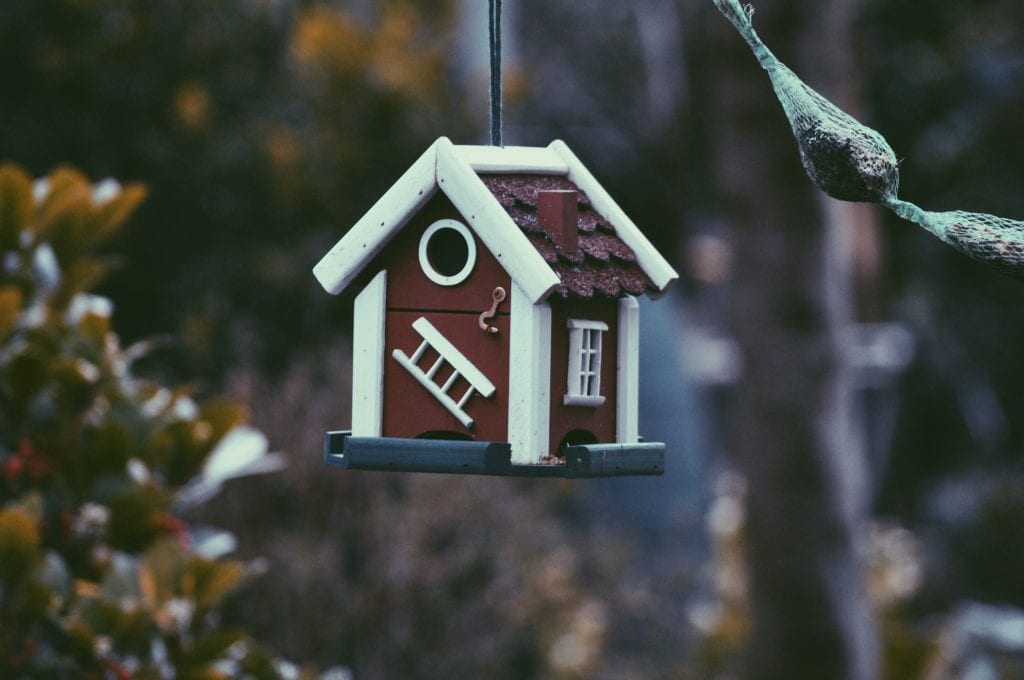
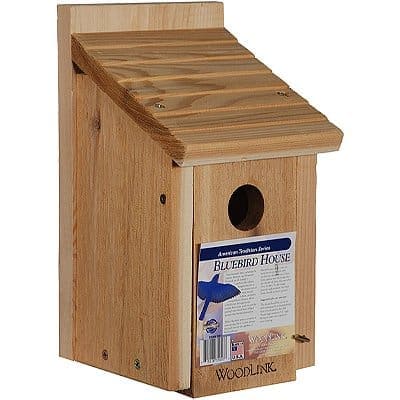
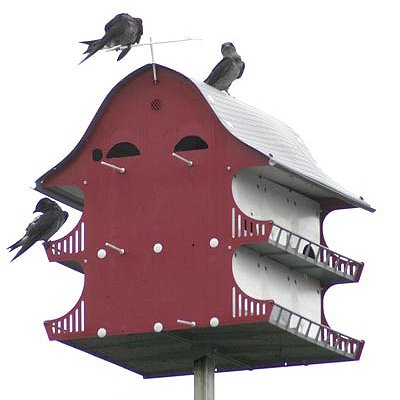
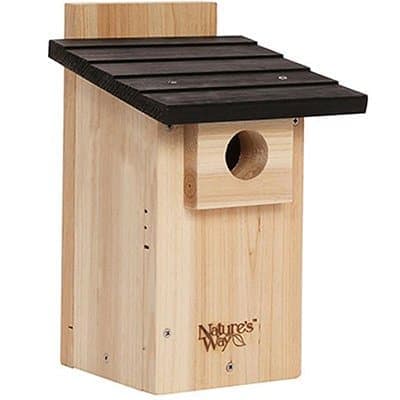
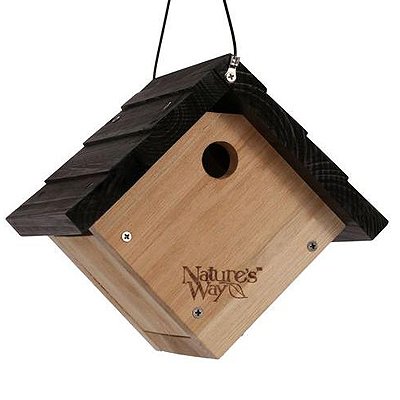
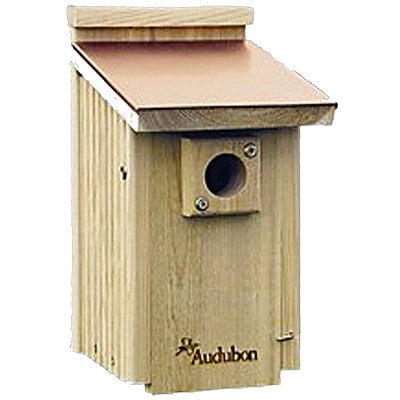
Please identify the red “Firehouse” bird house in the photo at the beginning of the article. I am looking for something decorative and functional.